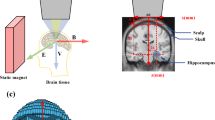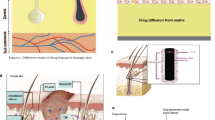Abstract
The influence of nonuniform cell shape and field orientation on the field stimulation thresholds of cardiac myocytes was studied both experimentally and computationally. The percent change in excitation threshold, which was studied with patch clamp technique, was found to be 182±83.1% (mean ±SD) higher when the electric field (EF) was parallel to the transverse cell axisversus the longitudinal axis (p<0.0006). On reversing the polarity of the applied EF, the percentage change in threshold was observed to increase by 98.9±71.0% (p<0.0002), implying asymmetry of the stimulation threshold of isolated myocytes. Finite element models were made to investigate the distribution of the transmembrane potential of these experimentally studied myocytes. A typical cell model showed that the maximum transmembrane potential induced on opposite ends of the cell was 39.1 mV and −46.5 mV for longitudinal field (aligned with the long axis of the cell), but was 40.5 mV and −44.8 mV for transverse field (aligned with the short axis of the cell). More significantly, it was found that the maximum transmembrane potential occurred at discrete points or “hot spots” on the cell membrane. It is hypothesized that the depolarization of the cell initiates at the hot spot and then spreads over the entire cell. The different excitation thresholds for different polarities of the applied EF can be explained by the different maximum induced at the opposite ends of the cell.
Similar content being viewed by others
References
Bardou, A. L., J. M. Chesnais, P. J. Birkui, M. C. Govaere, P. M. Auger, D. von Euw, and J. Degonde. Directional variability of stimulation threshold measurements in isolated guinea pig cardiomyocytes: relationship with orthogonal sequential defibrillating pulses.PACE 13:1590–1595, 1990.
Bardou, A. L., J. Degonde, P. J. Birkui, P. Auger, J. M. Chesnais, and M. Duriez. Reduction of energy required for defibrillation by delivering shocks in orthogonal directions in the dog.PACE 11:1990–1995, 1988.
Bardou, A. L., J. Degonde, and R. Saumont. A new method to minimize heart defibrillation energy: use of crossed delayed electric shocks.Innov. Tech. Biol. Med. 7:55–63, 1986.
Chen, P. S., P. D. Wolf, F. J. Claydon, E. G. Dixon, H. J. Vidaillet, N. D. Danieley, T. C. Pilkington, and R. E. Ideker. The potential gradient field created by epicardial defibrillation electrodes in dogs.Circulation 74:626–636, 1986.
Dillon, S. M. Optical recordings in the rabbit heart show that defibrillation strength shocks prolong the duration of depolarization and the refractory period.Circ. Res. 69:842–856, 1991.
Fain, E. S., M. B. Sweeny, and M. R. Franz. Improved internal defibrillation efficacy with a biphasic waveform.Am. Heart J. 117:358–364, 1989.
Frazier, D. W., W. Krassowska, P.-S. Chen, P. D. Wolf, E. G. Dixon, W. M. Smith, and R. E. Ideker. Extracellular field required for excitation in three-dimensional anisotropic canine myocardium.Circ. Res. 63:147–164, 1988.
Gaylor, D. C., K. Prakash-Asante, and R. C. Lee. Significance of cell size and tissue structure in electrical trauma.J. Theor. Biol. 133:223–237, 1988.
Greenbaum, R. A., S. Y. Ho, D. G. Gibson, A. E. Becker, and R. H. Anderson. Left ventricular fiber architecture in man.Br. Heart J. 45:248–263, 1981.
Gross, D., L. M. Loew, and W. W. Webb. Optical imaging of cell membrane potential changes induced by applied electric fields.Biophys J. 50:339–348, 1986.
Jones, D. L., G. J. Klein, G. M. Guiraudon, and A. D. Sharma. Sequential pulse defibrillation in humans: Orthogonal sequential pulse defibrillation with epicardial electrodes.J. Am. Coll. Cardiol. 11:590–596, 1988.
Jones, D. L., G. J. Klein, G. M. Guiraudon, A. D. Sharma, M. J. Kallok, J. D. Bourland, and W. A. Tacker. Internal cardiac defibrillation in man: pronounced improvement with sequential pulse delivery to two different lead orientations.Circulation 73(3):484–491, 1986.
Jones, D. L., G. J. Klein, M. F. Rattes, A. Sohla, and A. D. Sharma. Internal cardiac defibrillation: single pulse and variety of lead orientations.PACE 11:583–591, 1988.
Jones, J. L., R. E. Jones, and G. Balasky. Improved cardiac cell excitation with symmetrical biphasic defibrillator waveforms.Am. J. Physiol. 253:H1418-H1424, 1987.
Kavanagh, K. M., H. J. Duff, R. Clark, K. V. Robinson, W. R. Giles, and D. G. Wyse. Monophasic versus biphasic cardiac stimulation: mechanism of decreased energy requirements.PACE 13:1268–1276, 1990.
Kishida, H., B. Surawicz, and L. T. Fu. Effects of K+ and K+-induced polarization on (dV/dt)max threshold potential, and membrane imput resistance in guinea pig and cat ventricular myocardium.Circ. Res. 44:800–814, 1979.
Klee, M., and R. Plonsey. Stimulation of spheroidal cells—the role of cell shape.IEEE Trans. Biomed. Eng. BME-23: 347–354, 1976.
Knisley, S. B., T. F. Blitchington, B. C. Hill, A. O. Grant, W. M. Smith, T. C. Pilkington, and R. E. Ideker. Optical measurements of transmembrane potential changes during electric field stimulation of ventricular cells.Circ. Res. 72:255–270, 1993.
Knisley, S. B., W. M. Smith, and R. E. Ideker. Effect of field stimulation on cellular repolarization in rabbit myocardium. Implications for reentry induction.Circ. Res. 70(4): 707–715, 1992.
Plonsey, R., and R. C. Barr. Effect of microscopic and macroscopic discontinuities on the response of cardiac tissue to defibrillating (stimulating) currents.Med. Biol. Eng. Comput. 24:130–136, 1986.
Ranjan, R., M. G. Fishler, and N. V. Thakor. Electrical “hot spot” as a mechanism of defibrillation.Comput. Cardiol. 00:245–247, 1993.
Ranjan, R., M. G. Fishler, and N. V. Thakor. Influence of cell shape on field stimulation thresholds.Proc. IEEE/EMBS 15:848–849, 1993.
Streeter, D. D. J., S. M. Spotnitz, D. P. Patel, J. J. Ross, and E. H. Sonnenblick. Fiber orientation in canine left ventricle during diastole and systole.Circ. Res. 24:339–347, 1969.
Swartz, J. F., R. E. Jones, and R. Fletcher. Conditioning prepulse of biphasic defibrillator waveforms enhances refractoriness to fibrillation wavefronts.Circ. Res. 68:438–449, 1991.
Trayanova, N., and T. Pilkington. A bidomain model with periodic intracellular junctions: a one-dimensional analysis.IEEE Trans. Biomed. Eng. 40:424–433, 1993.
Tung, L., and J.-R. Borderies. Analysis of electric field stimulation of single cardiac muscle cells.Biophys. J. 63: 371–386, 1992.
Tung, L., N. Sliz, and M. R. Mulligan. Influence of electrical axis of stimulation on excitation of cardiac muscle cells.Circ. Res. 69(3):722–730, 1991.
Waller, B. F., and R. C. Schlant. Anatomy of the heart. In:The Heart: Arteries and Veins, edited by R. C. Schlant and R. W. Alexander. New York: McGraw Hill, 1994, pp. 104–108.
Weidmann, S. Electrical constants of trabecular muscle from mammalian heart.J. Physiol. 210:1041–1054, 1970.
Zhou, X., J. P. Daubert, P. D. Wolf, W. M. Smith, and R. E. Ideker. Size of the critical mass for defibrillation (abstract).Circulation 80 (Suppl. II):II-531, 1989.
Zhou, X., S. B. Knisley, P. D. Wolf, D. L. Rollins, W. M. Smith, and R. E. Ideker. Prolongation of repolarization time by electric field stimulation with monophasic and biphasic shocks in open chest dogs.Circ. Res. 68:1761–1767, 1991.
Author information
Authors and Affiliations
Rights and permissions
About this article
Cite this article
Ranjan, R., Thakor, N.V. Electrical stimulation of cardiac myocytes. Ann Biomed Eng 23, 812–821 (1995). https://doi.org/10.1007/BF02584480
Received:
Revised:
Accepted:
Issue Date:
DOI: https://doi.org/10.1007/BF02584480




